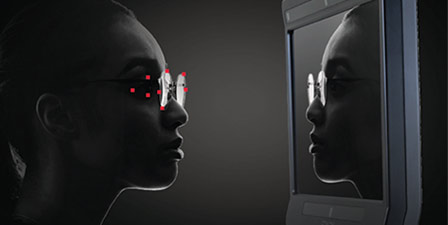
You know that feeling when a patient tries on an ophthalmic frame and you know that the others just won’t do. That “we have to stop right here, that’s the one” moment. It feels good as an optician to help a patient find a frame that looks, fits, and feels good. Being able to fit patients with frames that suit them in fit, functionality and fashion (the 3 F’s) is what sets a mediocre optician apart from a super star. A way to be successful in the dispensary is to develop a plan on how to approach the frame fitting experience for your patient. Always begin by examining the patient’s prescription, as this may limit your frame choices. An example is a very high plus prescription (+8.25-0.50x20) would not be aesthetically pleasing in a semi-rimless frame.
GETTING TO KNOW YOU
The next step is what some refer to as lifestyle dispensing. This is where you get to know your patient. Find out their type of work, hobbies and interests. Your job is to find out how they use their eyes during the day. This patient/optician relationship development will help not only find the best lenses, but also the type of frame.
RAPPORT
Would a rugged frame serve them best? Titanium for its durability and lightness? Subdued tones or colorful zing and zest? We can find out a lot about a patient in a short while as you develop a genuine rapport with them.
I like to see what the patient’s previous frames look like and then ask them what they liked and disliked about them. I have them put them on if they didn’t come in wearing them. I examine the fit and see how I can help improve upon that. I always start with the bridge. I find frames that fit the bridge best and work from there. Patients can see and feel the difference between an ill-fitting and good fitting bridge. Simultaneously, I am pulling frames that fit the bridge and the eyesize. Once I/we find the proper bridge and eyesize we move on to shape. I say try them all! Round, oval, rectangular, square, even unique shapes, as we are sometimes surprised. The same goes for color.
PLEASANT EXPERIENCE
The goal is to make this experience pleasant, fun, and a bit educational. The pleasurable part arises from you getting to know who your patient is as a person. Determine what colors look good on them, what their style is (conservative, artsy), and what they do for fun. A pleasant experience may bring referrals and that patient back the next time they need new eyewear.
FUN EXPERIENCE
You will be able to gauge the level of fun you will reach when interacting with your patient. It may not go any further than a smile, but the goal is to get to a point where the patient is actually enjoying choosing their eyewear with you.
EDUCATIONAL EXPERIENCE
It is possible and essential to weave education into the fitting of eyewear process. Explaining why a certain frame shape or design will not provide the desired results, or talking about frame material features and benefits shows the patient that you are a professional. You will likely expand your patient base by incorporating the 3 F’s and making the experience pleasant, fun, and educational because you are a super star optician!
To learn more about how to provide eyewear that will enhance patients’ features as well as provide them with improved vision, better performance and superior fit and comfort, check out our CE, The Journey from Expert Technician to Creative Artisan, at 2020mag.com/ce.












